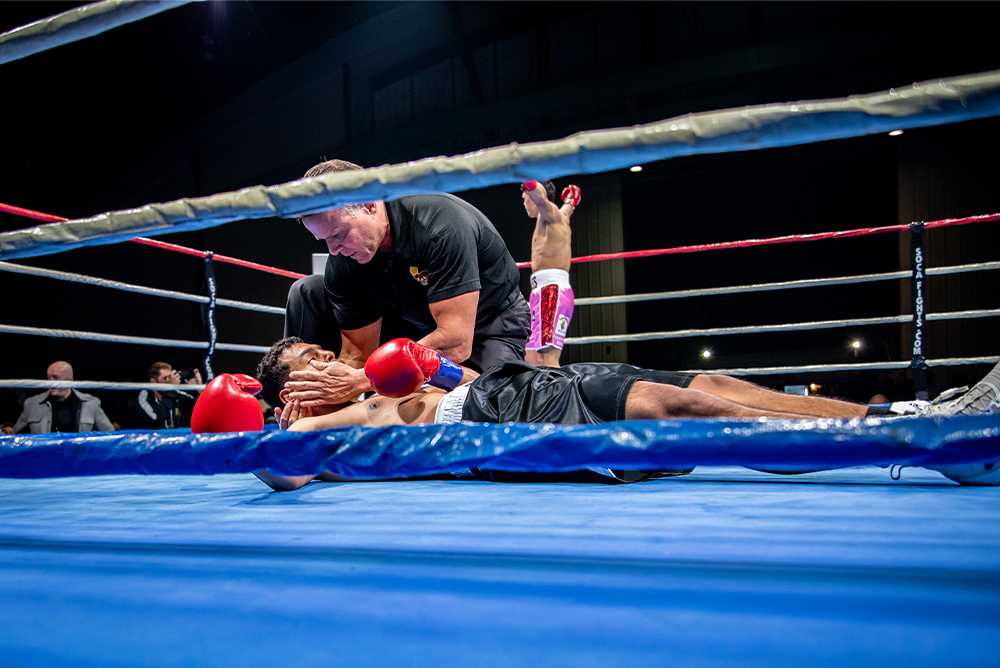
Scholar Rudy Mondragón writes about boxing’s underpaid opponents: overmatched fighters who usually lose, as the boxing world and its champions thrive. Fighter Francisco Alfaro and referee Thomas Taylor at a 2023 Costa Mesa, California match. Courtesy of author.
In the name of beer sales and taco Tuesday nights, Cinco de Mayo has morphed from a symbol of anti-imperialist struggle into a lucrative marketing opportunity for corporate America. Cinco de Mayo’s fight night—a stage for high-profile fights and staggering paydays, with renowned headliners like Oscar De La Hoya and Floyd Mayweather Jr., generating millions in revenue—has, too, become a cash grab for the boxing industry.
This Cinco de Mayo weekend, Saúl “Canelo” Álvarez, this era’s top earner, is scheduled to take on Jaime Munguía and defend his super middleweight world titles. Canelo, who is heavily favored to win, will earn a guaranteed purse of an estimated $35 million. Munguía will come away with a pretty payday, too.
But another class of boxers goes unnoticed: opponents, the unsung heroes of the boxing world whose job it is to battle it out to prop up superstar fighters.
Boxing employs opponents to build up the winning records of the fighters known as prospects, who sit below contenders and world champions within the hierarchy of the sport. The industry considers prospects, who have promising futures, investments to protect. Prospects often enjoy support from major promoters, including safeguards such as careful placement in matches meant to assure their success.
Opponents, in contrast, are used as fodder, expected to lose while receiving very little pay—all to facilitate the ascent of the very tiny sliver of fighters who hit it big. There are 24,612 male and 2,192 female registered professional boxers worldwide. With 17 weight classes, each with four world championship titles, there are only 136 world championship slots. Less than 1% of males and only about 3% of females reach these lofty heights.
People toil for little pay with success unlikely in many pursuits: acting, music, electoral politics. But the sting is especially harsh for boxers, who face constant physical peril in a business uniquely primed to exploit. In this winner-take-all industry, fighters lose through literal defeats in the ring and through material setbacks in the economy. As one boxer described it to me, opponents are workhorses sent to the slaughterhouse.
California usually regulates the most boxing matches of any U.S. state and has made strides to protect fighters, but pay disparity for opponents persists. In a forthcoming report from UCLA’s Latino Policy and Politics Institute, Abel Valenzuela Jr., José Hernández, and I analyzed compensation data from the California State Athletic Commission.
In 2021, over half of the 526 regulated boxing matches in California were four- and six-rounders, the prospect-developing bouts in which opponents are most likely to fight. The California State Athletic Commission requires a minimum compensation of $100 per round for professional boxers, who might train four to eight weeks for a bout. A minimum wage worker in California, earning $16 per hour, grosses around $2,773 for a month of work. But in 2021, the median compensation for a four-round fight was just $1,500.
Opponents face further precarity due to their classification as independent contractors, which makes them ineligible for work benefits, and the protections of federal, state, and local labor standards. What’s more, fighters are expected to pay their managers between a tenth and a third of their gross earnings, and their trainers a tenth as well. A four- to eight-week training camp can cost fighters anywhere from $200 to $2,000. Some opponents actually lose money on a fight.
Though they are expected to lose, boxing opponents have their reasons for fighting. Some are driven by a passion and love for the sport, and their sense of belonging within the boxing community. For others, being a boxer brings them status, visibility, and recognition. Opponents supplement their income with other jobs. One boxer told me it’s better to be a McDonald’s worker and be a boxer than to just work at McDonald’s. The status of being a prizefighter, regardless of their success in the ring, affords opponents with dignity, pride, and purpose.
In 2022, I interviewed Derrick*, an opponent from northern California with a winning percentage of 19%, in 26 fights. Derrick recounted fighting three times in a single year, earning just under $5,000. In the third of those bouts, he fought with an injured eye, resulting in a detached retina that sidelined him for over a year.
Despite the limitations of his peripheral vision after eye surgery, Derrick continues to fight. Knowing that he’s expected to lose only fuels his determination to fight harder, and aim for unexpected victories. “I’m not just going to stand there and just get hit,” he told me. “I’m someone who will go out there and give it to you. Someone who will go out there and fight you and not just take an easy loss.” This mindset embodies resilience and a refusal to be defeated easily.
The pursuit of dignity, pride, and purpose is inspirational. But it should not get in the way of recognizing the exploitation that persists in the brutal world of boxing.
This weekend’s cash cow, Canelo, became a world champion by beating underpaid opponents in his early career—foes carefully chosen because they were fighters he could easily beat, and thus build up his experience and record. In his first eight fights, Canelo won seven matches and tied another; collectively, the eight fighters he faced had a losing record of nine wins, 16 losses, and one draw. (Miguel Vazquez, whom Canelo defeated twice, is the exception; he eventually became a world champion.) Canelo’s career was built on their labor.
I don’t single out Canelo to place blame, but rather to illuminate systemic issues within boxing. Most boxing fans are content with knowing only a handful of celebrity boxers like Canelo, Tyson Fury, Anthony Joshua, and Ryan Garcia. But it takes tens of thousands of underpaid fighters to maintain the ecosystem that allows the stars to thrive, and the rest of us to enjoy mega-fight spectacles. As consumers of the sport, we must remember them on big match weekends and work to improve their working conditions.





Send A Letter To the Editors